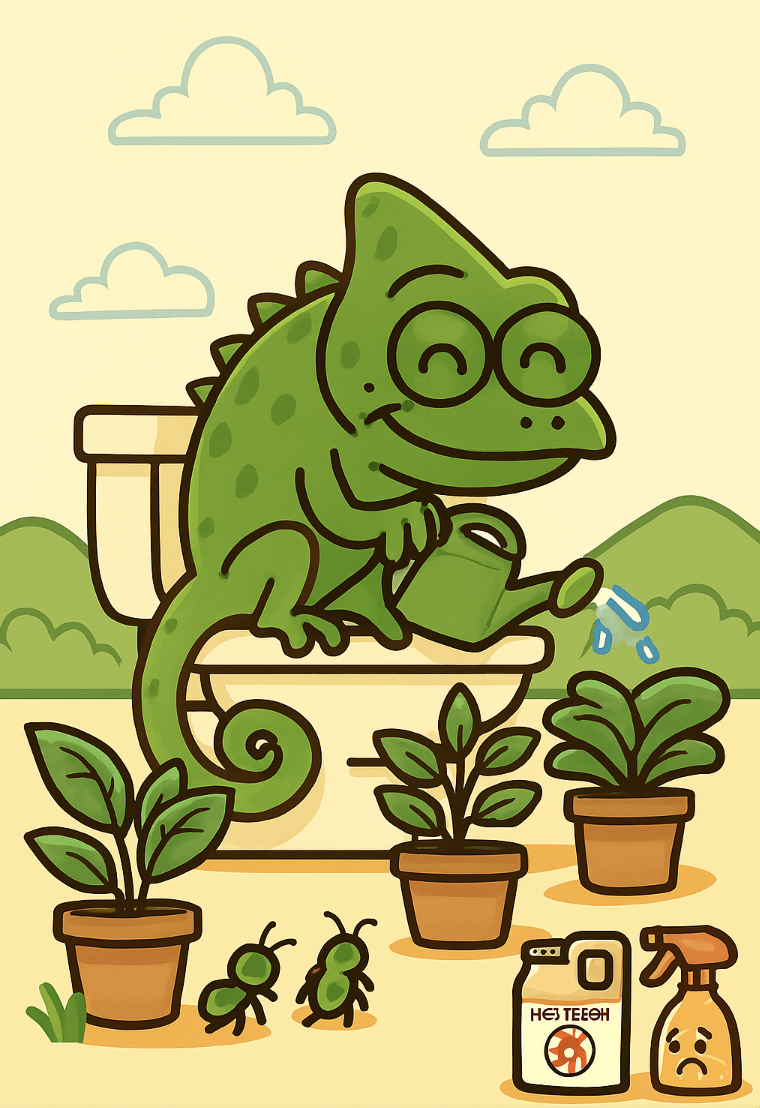Preparing Plants for Chameleon Enclosures

A practical guide to pesticide safety, pest irrelevance, and habitat priorities
Chameleon First, Always
In a chameleon enclosure, plants are cohabitants—but they are not equals. They exist to serve the chameleon's needs: structure, humidity, cover, and visual stability. Their health matters only insofar as it supports the animal's wellbeing. The enclosure is not a botanical garden. It is a life-support system for a reptile. Any plant preparation protocol must reflect this hierarchy.
Pests: Not a Threat to Chameleons
Common plant pests do not harm chameleons. Aphids, mites, thrips, fungus gnats—none attack or affect the animal directly. Quarantining plants to protect the chameleon from pests is unnecessary. The only valid concern regarding pests is their potential to infest the enclosure and disrupt plant health or humidity balance, which may indirectly affect the chameleon's environment. But the chameleon itself is not biologically vulnerable to these organisms.
Pesticides and Soil Additives: The Real Risk
The true hazard lies in chemical exposure. Plants sourced from commercial nurseries or garden centers may carry:
- Systemic pesticides:
These are absorbed into plant tissues and can persist for weeks. They are not removed by surface rinsing.
- Surface residues:
Spray-applied pesticides may linger on leaves and stems.
- Soil additives:
Fertilizers, fungicides, and wetting agents in commercial potting mixes can leach into the environment and can be infested or contaminate the skin, soles, eyes
While chameleons rarely ingest plant matter directly, incidental contact, incidental ingestion or exposure through misting can introduce trace toxins. For sensitive species or high-value setups, this risk warrants mitigation.
Two Valid Prep Methods
1. Full Quarantine (4–8 Weeks)
This method is cautious, thorough, and super sage in an exaggerated way. It is based on the pest life cycle (typically ip to 4 weeks) and the persistence of systemic pesticides.
Protocol:
• Remove all original soil and repot in organic, pesticide-free mix.
• Rinse leaves thoroughly with cold water.
• Isolate the plant in a clean, well-lit area away from other enclosures.
• Observe for signs of pests, mold, or leaf damage.
• Introduce plants gradually—one at a time—to avoid disrupting the chameleon's sense of territory.
This approach is ideal for sensitive species, high-value individuals, or setups where long-term stability is paramount
and where the environment created is considered to be in partnership with the chameleon,
or where the priority is the environment and chameleon is just the topof the iceberg.
2. Rinse-and-Go (Simplified Protocol)
This method is fast, practical, and widely used by keepers who prioritize efficiency and accept minimal risk.
Protocol:
• Source plants from reputable growers who minimize pesticide use.
• Rinse leaves thoroughly—twice—with cold water and let them dry.
• Replace the top layer of soil or repot entirely with organic mix.
This does not remove systemic pesticides, but it significantly reduces surface residues and soil contaminants. For most healthy chameleons, the risk from incidental contact or ingestion is considered low.
Repeat the rinse if unsure. Cold water, twice, then dry. It's simple and effective.
Final Thought
Plants are cohabitants—but they exist to serve the chameleon. Their health is secondary. The goal is a clean, stable, and safe habitat. Whether you choose full quarantine or a simplified rinse-and-go approach, the priority remains the same: protect the chameleon, minimize disruption, and maintain environmental integrity. Do not let plant aesthetics, convenience, or misplaced caution override the needs of the animal.
The bigger the enclosures the more realistic is to create a healthy microhabitat and care fir plants makes more sense. In minimal enclosures in which 99% of the chameleons are kept in captivity, the health of the chameleon goes first and plants serve it.